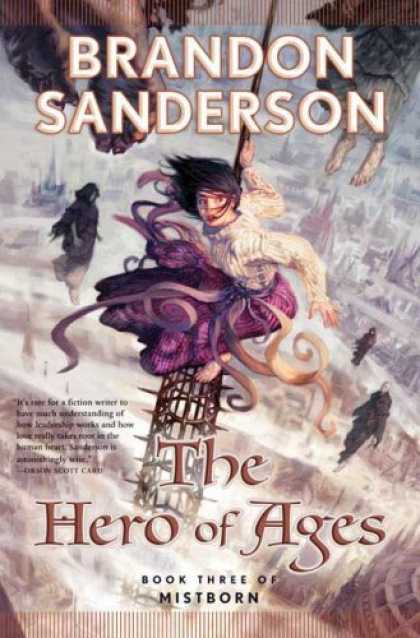
Brandon Sander's Mistborn comes to it's conclusion in the Hero of Ages.
Some of the things I'll be discussing below I've mentioned before, but as they continue to come up in books, they tend to reinforce their utility for both writing fiction and crafting entertaining games.
1. Vague prophecies. The Hero of Ages is an old prophecy that started off the series. It's been mentioned time and time again. It's been vague enough that many could fit the title, and when we, the readers finally discover who the hero of ages is, I wouldn't be shocked if many readers, much like I, were indeed fooled by the way the books had gone up to this point.
It wasn't a bluff nor a lie as people thought one character or another was the hero, but because it was vague, it was applicable to many fields. In a role playing game that may have several players in it, this is a good thing, allowing different players to fill in different parts of a propehcy.
2. The environment. The main foe here, Ruin, isn't a physical being. It's one of power. On a whole seperate plane of existance. It's destroying the world through continuous ash fall from volcanic mountains and earthquakes. No matter how might a physical foe, such as a dragon or giant is, often, there are ways to beat them that fit into the content of a role playing game. When it's trying to see through ash fall that storms down, the prospects of using a daily power or a utility power against it aren't quite so good.
Environmental disasters also offer something that Game Masters can use and that's a time limit. If the players are unable to keep moving, then the world ends and they lose. This is useful if you're players are the types that like to expand all of their neat toys in each and every fight and suffer the "fifteen minute a day" adventuring syndrome. By putting a time line on events, they don't have the time to wait a full day and recover their abilities, they have to keep going.
3. The prize. In this case, if the heroes lose, the world is doomed. And even if they win, the world is forever changed. At the end level of almost every edition of D&D (Advanced, 2nd, 3rd, and 4th), once the players can start using 9th level spells, and have magic items of the appropriate level, they should be the ones helping to determine the final fate of the setting. Go big or go home as the old saying goes.
4. Campaign styles: Here, the author has done a very solid job of making the campaign setting be very coherent. The world building ties together very nicely and many elements of it come together in this final volume. One of the benefits of doing a home brew as opposed to an off the shelf setting, is a home brewed can allow the Game Master to hit specific elements and themes and have them be consistant. Purchased settings, like Forgotten Realms and others, tend to be very emcompassing, allowing a wide range of player arche types to mix and mingle with one another without regards to the consistency of the actual campaign setting. It works if you don't examine things too closely but can fall apart if you try to figure out why faction Y hasn't simply abosrbed country B, etc...
In addition, some feel that they shouldnt' change an established campaign setting. Be making up your own, you completely negate that whole fear and worry. You can hold different games in different eras, allowing players to see the effects of their previous characters on the campaign setting, which can be very satisfying.
The Hero of Ages brings a satisfying conclussion to the Mistborn series and does so in a fasion that leaves the setting changed and the reader, perhaps a little shocked at the events, but satisfied nontheless.





No comments:
Post a Comment